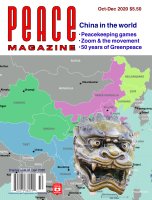The clashes between China’s People’s Liberation Army and Indian Army along the Himalayan border last June were the most serious in several years, but a reminder of China’s pattern of incremental expansionism exhibited since the sixties. China has waged 23 territorial disputes with her neighbours since 1949, including sovereignty issues over Hong Kong, Macau, and Taiwan. All but six have been resolved.
While both India and China claim the outbreaks this past summer were provoked by the other, satellite images provide indisputable evidence of the Chinese build-up of troops in Ladakh’s Galwan Valley vastly exceeding that of India’s military. These are arid regions of high mountains (nearly 19,000 feet above sea level) where the rarefied atmosphere and bone-chilling temperatures pose a challenge for any human activity, let alone military manoeuvres.
Before India gained independence in 1947 its northern border with China, drawn up by the British in 1930, was initialed but never signed by the Chinese. As such, the Line of Actual Control (LAC) remains an undemarcated boundary.
After the hand-to-hand clashes last June, battlefield commanders on both sides have had several rounds of discussions aimed at resolving issues and refraining from such outbreaks. A television station in Beijing claims to concur, judging from their coverage of this dispute; but the recent flare up at Pangong Lake and the repeated failure of negotiations signal China’s true intentions.
Until August 2019, the State of Jammu & Kashmir (J&K) was an autonomous region of India with a Muslim majority. However, Prime Minister Narendra Modi unilaterally repealed Article 370 of the Indian Constitution, which protected Kashmiri residents from mass influx of Indians from other states.
The pandemic served as a pretext for Delhi to impose a severe lockdown on residents, most of whom resent the omnipresence of Indian soldiers deployed primarily to block infiltrators from Pakistan-occupied Kashmir. Ladakh and J&K are now part of Union Territory—a change that enables Indians to purchase and occupy land and thereby change the demographics of both states and disenfranchise Kashmiri Muslims, a priority for the BJP’s Hindutva agenda.
Ever since the 1947 partition, Pakistan has claimed all of Kashmir by virtue of its majority Muslim population. However, the founding fathers of India insisted on establishing a secular state, guaranteeing citizens freedom of worship and speech, regardless of caste or creed.
But Modi’s revocation of this important clause in the constitution has angered progressive thinkers in India and infuriated the Pakistan authorities and their ally, China.
China’s expansionism is evident: They have already occupied Aksai Chin—an integral part of J&K—and claim Arunachal Pradesh (North East India), which they call Southern Tibet. But some analysts believe Beijing’s recent outburst was sparked by Modi’s move to involve the US and even the “Quad” (Vietnam, Japan, Philippines, and Australia) in its border disputes.
The Indian Ministry of Defence initially admitted that Chinese troops had “transgressed” into Indian territory last May/June, but this statement was later removed from their website. Moreover, Modi declared that “there was no intrusion.“ The Chinese gleefully agreed and await Modi’s next move. The official denial of China’s encroachment into Indian territory leaves much of the citizenry unaware.
Given the BJP’s control over media, universities, large corporations, most states, and the lack of any viable opposition, Modi has transformed India into a majoritarian nation where dissent is a crime and minorities are reduced to second-class citizens at best.
To continue negotiating with China may still be the best option, as neither side wants a war, but India must appoint its best diplomats and exercise greater assertion at the table. As long as Xi Ping remains in power, any expectations of a just and fair settlement of border issues is remote. This makes it vital for India to bolster its defence capability in the north to fend off hostile neighbours.
Subir Guin is an editor of Peace.




Comments